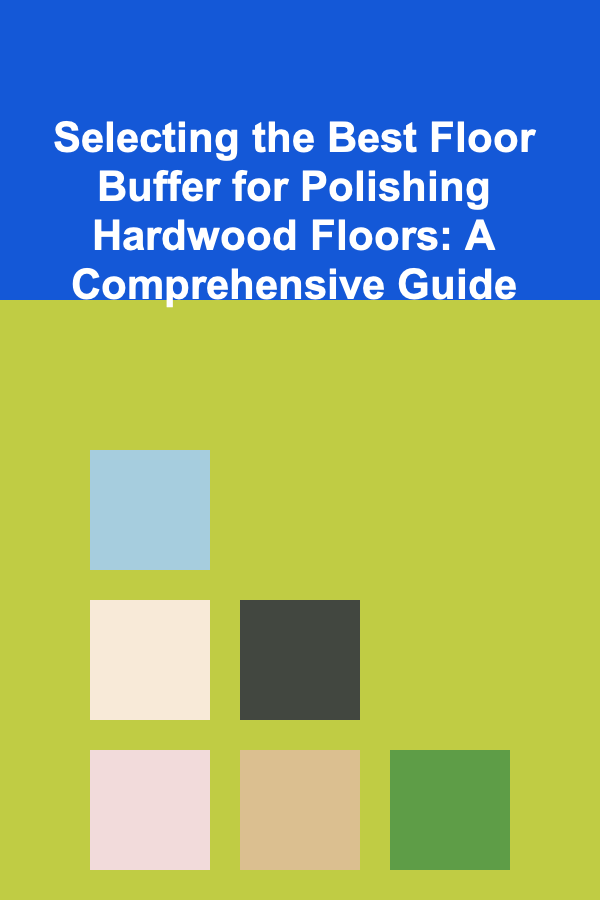
Selecting the Best Floor Buffer for Polishing Hardwood Floors: A Comprehensive Guide
ebook include PDF & Audio bundle (Micro Guide)
$12.99$6.99
Limited Time Offer! Order within the next:

Maintaining the beauty and luster of hardwood floors requires regular care, and polishing is a crucial part of that process. A floor buffer, also known as a floor polisher or floor machine, is an indispensable tool for achieving a professional-looking finish. However, with a plethora of models available on the market, selecting the right floor buffer for your hardwood floors can be a daunting task. This comprehensive guide will delve into the key factors to consider, helping you make an informed decision and choose the best floor buffer to meet your specific needs.
Understanding the Importance of Polishing Hardwood Floors
Before diving into the selection process, it's essential to understand why polishing is so important for hardwood floors. Polishing offers a multitude of benefits, including:
- Enhancing Appearance: Polishing removes surface scratches, scuffs, and dullness, restoring the floor's original shine and bringing out the natural beauty of the wood grain.
- Protecting the Finish: A polished surface creates a protective layer that shields the underlying finish from wear and tear, extending the life of your floors.
- Improving Cleanliness: A smooth, polished surface is less porous and easier to clean, preventing dirt and grime from becoming embedded in the wood.
- Increasing Durability: Regular polishing can help strengthen the floor's finish, making it more resistant to scratches, stains, and moisture damage.
Types of Floor Buffers for Hardwood Floors
Floor buffers come in various types, each with its own advantages and disadvantages. Understanding the different types is crucial for selecting the one that best suits your needs and budget.
1. Rotary Floor Buffers (Single-Disc Machines)
Rotary floor buffers are the most common type and are often used for a variety of tasks, including polishing, scrubbing, and stripping. They feature a single rotating brush or pad that spins at a relatively high speed. Their simplicity and versatility make them popular choices, but they also require more skill to operate effectively.
Pros:
- Versatile: Can be used for polishing, scrubbing, and stripping.
- Powerful: Effective for removing tough stains and scratches.
- Relatively affordable: Generally less expensive than other types of buffers.
Cons:
- Can be difficult to control: Requires experience and skill to avoid swirl marks and uneven polishing.
- Can damage floors if used improperly: High speed and aggressive pads can strip the finish or damage the wood.
- Can be heavy and bulky: May be difficult to maneuver in tight spaces.
2. Orbital Floor Buffers (Dual-Action Machines)
Orbital floor buffers feature a pad that moves in a circular or orbital motion. This motion is less aggressive than the rotary action of a single-disc machine, making them easier to control and less likely to cause damage. They are a good option for beginners and those with delicate hardwood floors.
Pros:
- Easy to control: Less likely to cause swirl marks or uneven polishing.
- Safer for delicate floors: Less aggressive action reduces the risk of damage.
- Good for beginners: Easier to learn and operate than rotary buffers.
Cons:
- Less powerful than rotary buffers: May not be effective for removing tough stains or scratches.
- Can be slower than rotary buffers: May take longer to polish large areas.
- Can be more expensive than rotary buffers: Often feature more advanced technology.
3. Random Orbital Floor Buffers
Random orbital floor buffers are a variation of orbital buffers. They combine a spinning and oscillating motion, further minimizing the risk of swirl marks. The random movement prevents any single point from receiving concentrated pressure for too long, making them extremely user-friendly and ideal for maintaining a consistent finish. While often considered the safest option for hardwood floors, they may not provide the same level of deep cleaning as other types.
Pros:
- Extremely safe for hardwood: Minimal risk of damage or swirl marks.
- Very user-friendly: Easy to learn and operate, even for beginners.
- Consistent finish: Random movement ensures even polishing.
Cons:
- Limited power: Not suitable for heavy-duty cleaning or deep scratch removal.
- Can be more expensive: The advanced mechanism often increases the price.
- May require more passes: To achieve desired results, particularly on floors with significant wear.
4. Cylindrical Brush Floor Buffers
Cylindrical brush floor buffers use rotating cylindrical brushes instead of pads. These brushes are particularly effective at cleaning floors with textured surfaces or grout lines. While primarily designed for scrubbing, some models can be used for polishing with the appropriate brush attachments. They offer a different cleaning action compared to pad-based buffers.
Pros:
- Excellent for textured surfaces: Effectively cleans floors with grooves or imperfections.
- Effective for grout lines: Reaches deep into grout lines to remove dirt and grime.
- Can be used for scrubbing and polishing: Versatile with the right attachments.
Cons:
- May not be ideal for smooth hardwood: The brush action can be too aggressive for delicate finishes.
- Less common for hardwood polishing: Primarily used for scrubbing applications.
- Can be more expensive than rotary buffers: The specialized brush design adds to the cost.
Key Factors to Consider When Selecting a Floor Buffer
Once you understand the different types of floor buffers, you need to consider several key factors to make the right choice for your specific needs.
1. Floor Type and Finish
The type of hardwood flooring and its finish are crucial considerations. Different finishes have varying levels of sensitivity and require different polishing techniques. For example:
- Polyurethane Finishes: These are durable and resistant to wear and tear, making them suitable for most types of floor buffers. However, it's still important to use the appropriate pads and polishing compounds.
- Wax Finishes: These finishes are more delicate and require special care. Avoid using harsh chemicals or abrasive pads that can damage the wax. Orbital or random orbital buffers are generally recommended for waxed floors.
- Oil Finishes: These finishes are penetrating oils that enhance the natural beauty of the wood. Use polishing compounds specifically designed for oil-finished floors and avoid over-polishing.
- Pre-finished Hardwood: Follow the manufacturer's recommendations for cleaning and polishing. Some pre-finished floors have special coatings that require specific products.
Consider the age and condition of your floors. Older floors may have worn finishes that are more susceptible to damage. Always test the buffer and polishing compound in an inconspicuous area before applying it to the entire floor.
2. Size of the Area to be Polished
The size of the area you need to polish will influence the size and power of the floor buffer you choose. For small areas, such as hallways or bathrooms, a smaller, more maneuverable buffer will suffice. For larger areas, such as living rooms or dining rooms, a larger, more powerful buffer will be more efficient.
Consider the maneuverability of the buffer. Can it easily navigate around furniture and tight corners? Is it lightweight enough to carry up and down stairs?
3. Frequency of Use
If you plan to polish your hardwood floors frequently, invest in a high-quality, durable floor buffer that can withstand regular use. If you only plan to polish your floors occasionally, a less expensive model may suffice.
Consider the maintenance requirements of the buffer. Does it require regular cleaning or lubrication? Are replacement parts readily available?
4. Budget
Floor buffers range in price from a few hundred dollars to several thousand dollars. Set a budget before you start shopping and stick to it. Keep in mind that a more expensive buffer may offer better performance, durability, and features, but it's not always necessary to spend a fortune to get a good quality machine.
Consider the cost of accessories, such as polishing pads, bonnets, and cleaning solutions. These costs can add up over time.
5. Power Source: Corded vs. Cordless
Floor buffers are typically available in corded and cordless models. Corded buffers offer consistent power and are ideal for larger areas where you don't want to worry about battery life. Cordless buffers offer greater portability and flexibility, making them suitable for smaller areas or areas where access to power outlets is limited. Consider the convenience and power requirements of each type before making a decision.
6. Pad Size and Type
The size and type of polishing pad are crucial for achieving the desired results. Different pads are designed for different purposes, such as polishing, buffing, and cleaning.
- Microfiber Pads: Excellent for polishing and buffing, leaving a smooth, streak-free finish.
- Wool Pads: More aggressive than microfiber pads and are suitable for removing scratches and imperfections.
- Foam Pads: Versatile pads that can be used for polishing, buffing, and cleaning.
- Scrubbing Pads: Designed for cleaning and removing stubborn stains.
Choose the appropriate pad size for your floor buffer. Using a pad that is too small or too large can result in uneven polishing.
7. Speed Settings
Some floor buffers offer variable speed settings, allowing you to adjust the speed to match the task at hand. Lower speeds are ideal for polishing delicate finishes, while higher speeds are suitable for removing scratches and imperfections. Choose a buffer with adjustable speed settings for greater versatility.
8. Weight and Ergonomics
The weight and ergonomics of the floor buffer can significantly impact your comfort and efficiency. A lightweight buffer is easier to maneuver and less tiring to use, especially for extended periods. Look for a buffer with an ergonomic handle and adjustable height to reduce strain on your back and arms.
9. Noise Level
Floor buffers can be noisy, especially rotary models. If noise is a concern, choose a buffer with a lower decibel rating. Some manufacturers offer models with noise-reduction technology.
10. Additional Features
Some floor buffers offer additional features, such as:
- Edge Cleaning: Designed to clean close to walls and baseboards.
- Solution Dispensing: Automatically dispenses cleaning solution onto the floor.
- Dust Collection: Collects dust and debris to prevent it from spreading around the room.
Consider whether these features are important to you and whether they justify the additional cost.
Steps for Polishing Hardwood Floors with a Floor Buffer
Once you have selected the right floor buffer, follow these steps to polish your hardwood floors effectively:
- Prepare the Floor: Thoroughly sweep or vacuum the floor to remove dirt, dust, and debris.
- Clean the Floor: Clean the floor with a hardwood floor cleaner to remove any remaining dirt or grime. Allow the floor to dry completely.
- Apply Polishing Compound: Apply a thin, even layer of polishing compound to the floor according to the manufacturer's instructions.
- Polishing: Attach the appropriate polishing pad to the floor buffer. Turn on the buffer and move it slowly and evenly across the floor, overlapping each pass slightly.
- Buffing: Once the polishing compound has dried, attach a clean buffing pad to the floor buffer and buff the floor to a high shine.
- Clean Up: Vacuum or sweep the floor to remove any remaining dust or debris.
Safety Precautions
Always follow these safety precautions when using a floor buffer:
- Wear safety glasses and gloves: Protect your eyes and hands from dust and chemicals.
- Read the manufacturer's instructions: Familiarize yourself with the proper operation and safety procedures for your floor buffer.
- Keep children and pets away from the work area: Floor buffers can be dangerous if used improperly.
- Do not use the buffer on wet floors: This can create a slip hazard.
- Unplug the buffer before changing pads or performing maintenance: This will prevent accidental starts.
Conclusion
Selecting the best floor buffer for polishing hardwood floors requires careful consideration of several factors, including floor type, area size, frequency of use, budget, and features. By understanding the different types of floor buffers and the key factors to consider, you can make an informed decision and choose the perfect machine to maintain the beauty and luster of your hardwood floors for years to come. Remember to prioritize safety and follow the manufacturer's instructions for optimal results. With the right floor buffer and proper technique, you can achieve a professional-looking finish and enjoy the beauty of your hardwood floors.

How to Create a Side Hustle for Extra Income
Read More
How to Make Extra Income to Boost Your Home Budget
Read More
How to Make Your Own Eco-Friendly All-Purpose Cleaner
Read More
How to Use Mirrors in Home Staging to Create More Light
Read More
How to Discover Series with Standout Performances
Read More
Exploring the History of the Universe in Ten Steps
Read MoreOther Products

How to Create a Side Hustle for Extra Income
Read More
How to Make Extra Income to Boost Your Home Budget
Read More
How to Make Your Own Eco-Friendly All-Purpose Cleaner
Read More
How to Use Mirrors in Home Staging to Create More Light
Read More
How to Discover Series with Standout Performances
Read More